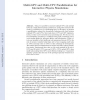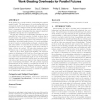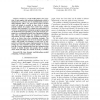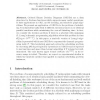96 search results - page 2 / 20 » Executing task graphs using work-stealing |
EUROPAR
2010
Springer
13 years 7 months ago
2010
Springer
Today, it is possible to associate multiple CPUs and multiple GPUs in a single shared memory architecture. Using these resources efficiently in a seamless way is a challenging issu...
SPAA
2009
ACM
14 years 8 months ago
2009
ACM
Work stealing is a popular method of scheduling fine-grained parallel tasks. The performance of work stealing has been extensively studied, both theoretically and empirically, but...
IPPS
2010
IEEE
13 years 5 months ago
2010
IEEE
Abstract--NABBIT is a work-stealing library for execution of task graphs with arbitrary dependencies which is implemented as a library for the multithreaded programming language Ci...
ICPP
1999
IEEE
13 years 11 months ago
1999
IEEE
Task graph scheduling has been found effective in performance prediction and optimization of parallel applications. A number of static scheduling algorithms have been proposed for...
WEA
2005
Springer
14 years 1 months ago
2005
Springer
Ordered Binary Decision Diagrams (OBDDs) are a data structure for Boolean functions which supports many useful operations. It finds applications in CAD, model checking, and symbol...




